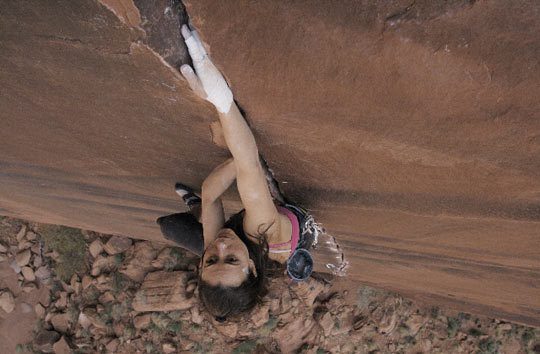Watch Steph Davis on Splitter Conception 5.13 Crack

Dean Potter made the first free ascent of Conception 5.13 in 2003, an aid route originally called Acromaniac 5.10 A0 in Day Canyon near Moab, Utah. Potter renamed the route Concepcion after the late José Pereyra’s mother. “The last time I saw José we had planned on spending the winter climbing in Utah,” he said after his first free ascent. “Then he went to Mexico and died [in a rockfall accident at El Potrero Chico]. When I got the news I was pretty disturbed. The next day I went out and found this amazing splitter.”
Concepcion starts in a thin seam and widens to a hand-and-fist crack at the top where Potter bypassed the original anchors and led the route as a big 70-metre pitch. It begins with a V9/10 boulder problem featuring a jump to a flaring pin scar, followed by a second crux of similar difficulty at 15 metres, with a long crank on tiny crimps. Then the crack leans awkwardly and widens too wide for fingers and not big enough for hands.
Apart from the first piece, a micro-cam that his belayer and wife at the time, Steph Davis, slotted in by standing on his shoulders, he placed his own protection. “I didn’t want to be carrying [the weight of large] cams when I did the cruxes,” he said. “It was cool to climb the hardest crack I’d ever seen and then finish it with a 100-foot runout.”

Steph Davis and Conception
On April 6, 2008, Davis made the first female ascent and third ascent of Conception shortly after it was repeated by Alex Honnold. Davis described Concepcion as her most technically demanding project ever, as the crack is off-size for her in both the finger and offwidth sections.
“In the final crux section of the rattly splitter I was actually falling out of the crack as I jabbed between ring locks,” Davis said after her send. “So I just started yelling, and somehow flew back into the rock, doing move after move at maximum exhaustion, almost in a warrior trance state.” She placed only two cams in the last 20 metres, which is the second pitch of the original route Acromaniac.
“Since the upper section was that cupped hands/almost fist size in loose, steep, sandy rock (rather than sinker hand jams, which would have been safe with no gear), I decided it was worth the weight to bring two cams and run it out a little less, rather than risk a 150 footer onto the old pin anchor if something broke,” she said.
“This climb was really physical for me, and in the end, I needed to just get stronger to be able to let go and place gear and have the weight of that much rope out below me through the rattly fingers section. So hurting my legs in random accidents was actually good.”
The splitter crack has been climbed a number of times, including by Canadian Jean Pierre Ouellet and a recent onsight by Adam Ondra.
She recently posted on social media about the climb, read what she had to say in 2019 and watch the send below.


